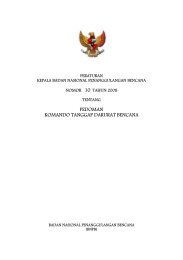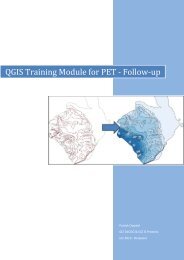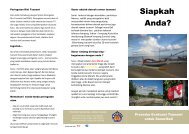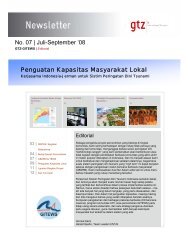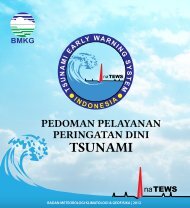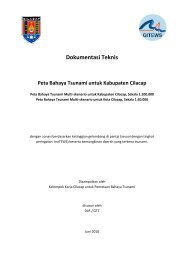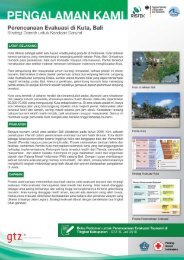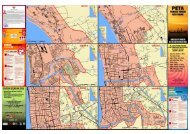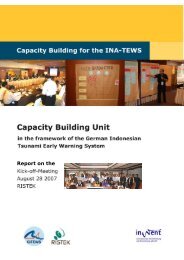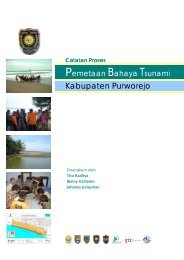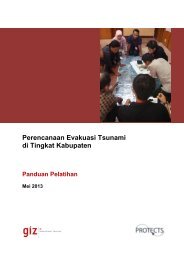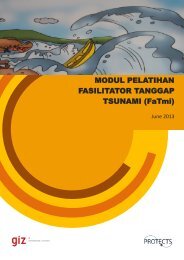GTZ IS Newsletter No. 1 - GITEWS
GTZ IS Newsletter No. 1 - GITEWS
GTZ IS Newsletter No. 1 - GITEWS
You also want an ePaper? Increase the reach of your titles
YUMPU automatically turns print PDFs into web optimized ePapers that Google loves.
<strong>No</strong>. 01 | January-March ‘07<strong>GTZ</strong>-<strong>GITEWS</strong> | EditorialSeite 1Capacity Building in Local CommunitiesGerman-Indonesian Cooperation for Tsunami Early Warning System<strong>GTZ</strong>-<strong>IS</strong> Project for Capacity Building inLocal Communities |02Updates from Pilot Areas in Sumatra,Java and Bali |03 - 05BMG – the source of Early Warning inIndonesia |06Capacity Building for Local SOP: aninter-institutional effort in three regions |07Foto zum Artikel02 | <strong>GITEWS</strong> Project03 | News from Pilot Areas06 | BMG Update07 | SOP Workshops08 | Warning Chain Analysis09 | Publications10 | Introducing the TeamEditorialTsunami Early Warning requires cooperation of people and institutionsfrom international, national and local level. This kind of cooperationneeds a steady communication and exchange of information. With thisquarterly newsletter the Pilot Project “Capacity Building in Local Communities”will contribute to that aim. As our partnership include localand national Indonesian institutions, German <strong>GITEWS</strong> partners andinternational organizations, this newsletter will be published in Indonesianand English language.As a Capacity Building Project for local communities our attention naturallyfocuses on people and institutions in coastal communities in tsunamiprone areas. Three Pilot Areas have been selected in the pastfew months, cooperation agreements discussed with the local governmentsand first activities implemented. In this edition of the newsletterwe will introduce all three Pilot Areas to you.Dialogue between local stakeholder and national institutions is essentialin order to define the links and interfaces between the differentparts of the warning chain. A discussion forum last September was followedby a series of workshops on local SOP development, where localand national institutions exchanged information and discussed howwarnings could be disseminated to the local communities. At the sametime this initiative is a good example for cooperation between internationalsupport agencies (<strong>GTZ</strong>-<strong>IS</strong>, IFRC, UNDP, USAID), who jointly organizedand sponsored these events.<strong>GITEWS</strong>Best regardsHarald Spahn, Team Leader <strong>GTZ</strong>-<strong>IS</strong>.
<strong>No</strong>. 01 | January-March‘07 | <strong>GTZ</strong>-<strong>IS</strong> <strong>GITEWS</strong> | The Project |page 2About Our Project„Capacity Building in Local Communities“Early Warning is essential to save lives and reduce damages when a Tsunamistrikes. Indonesia, in cooperation with Germany and other countries aswell as International Organisations, is setting up a Tsunami Early WarningSystem (INA-TEWS) for the whole country. This system will be an essentialpart of an integral Tsunami Early Warning System for the entire Indian OceanRegion.In order to support the implementationof a tsunami early warning system inthe Indian Ocean and especially in Indonesia,the BMBF provides 45 millionEuro for the development of core elementsof a tsunami early warning system(<strong>GITEWS</strong>). The German contributionto the detection system of earthquakesand tsunamis for Indonesiarelies on a marine measurement procedureand a seismological researchnetwork. Together with national andinternational partners, a concept is beingdeveloped under the guidance ofGeo Research Center Potsdam (GFZ)that will significantly reduce the warningtime of a tsunami using real-timedata transfer, predetermined floodingscenarios in costal regions as well asby creating warning reports directly.One component of the German–Indonesian Cooperation for TsunamiEarly Warning focuses on assuringthat people in risk areas are alerted intime and execute the anticipated responsein a short time to minimizelosses. The project “Capacity Buildingin Local Communities”, implementedby <strong>GTZ</strong>-<strong>IS</strong>, cooperates with LocalGovernments and other stakeholdersto develop warning and preparednessmechanism in 3 Pilot Areas.The results from this project shall enableother coastal communities to linkthemselves to the INA-TEWS and toprepare better for future Tsunamis.The project started in June 2006 andis scheduled up to the end of 2008.The project offers advisory services forlocal stakeholder in the followingfields:… identifying local tsunami risksTechnical advisory for hazardanalysis to identify areas affectedby tsunamis and safezones.Support for vulnerabilityanalysis… establishing the warning chainon the local levelProviding information to understandthe system and howto link.Clarifying roles and responsibilities.Developing Standard OperationalProceduresDesign of warning disseminationsystem and access tonew technologies… preparing for appropriate reactionto the warningHarald SpahnAwareness rising and educationaltrainingDeveloping contingencyplanningEstablishing evacuation plansharald.spahn@gtz.deOur PartnersThe <strong>GITEWS</strong> project iscoordinated with R<strong>IS</strong>TEKand includes partnershipwith several national Indonesianinstitutions.On the national level ourproject has establishedworking relations with LIPI,BMG, KOMINFO andMOHA.On the local level our directpartners are the LocalGovernments in the threePilot Areas. Working relationsare also establishedwith local NGO, PMI aswell as the Private Sector.
<strong>No</strong>. 01 | January-March‘07 | <strong>GTZ</strong>-<strong>IS</strong> <strong>GITEWS</strong> | Pilot Areas |page 3[gtz_BILDUNTERSCHRIFT] Arial 6pt, max. 2zeiligNews from Pilot AreasPadangPadang is the capital of West Sumatra Province. Almost 1 million people livein the city. Geographically, it lays on the west coast of Sumatra Island and hasa direct border with the open sea (Indian Ocean). Padang is considered asone of the most vulnerable cities towards tsunami hazard in the Indian Oceanregion.Establishment ofPUSDALOPSin PadangPadang City was the first Pilot Area tojoin the <strong>GITEWS</strong> project. <strong>GTZ</strong>–<strong>IS</strong> establishedpartnership with the localgovernment (Pemerintah KotaPadang) and with the local NGO KO-GAMI (Komunitas Siaga Tsunami).A cooperation agreement betweenPEMKO Padang and <strong>GTZ</strong> <strong>IS</strong> wassigned on 19 th of <strong>No</strong>vember of 2006 inPadang by Mr. Fauzi Bahar, the Mayorof Padang and Harald Spahn, <strong>GTZ</strong>-<strong>IS</strong>Team Leader.The Mayor hopes that Padang will bethe first city who will have an end toend Tsunami Early Warning System inIndonesia. Mr. Indra Catri, the assistantto the mayor, is appointed to be incharge representing the local government.Activities implemented during the firstmonths of the cooperation in Padang:• A participatory workshop forstakeholder analysis and a studyon “Warning Chain Analysis” forWest Sumatra Province and KotaPadang were conducted to clarifywhich institutions are involved andwhat are their roles regardingTsunami Early Warning.• Baseline studies regarding thelocal legal framework and theavailable information on tsunamihazard in Padang were conductedRepresentatives from a Padang WorkingGroup participated in the SOP-Workshops and hosted the secondworkshop in <strong>No</strong>vember 2006.<strong>GTZ</strong> short term consultant Juan CarlosVillagran de Leon (UNU) supportedthe Padang Working Group in <strong>No</strong>vember2006 in the development processof local SOP and evacuation planning.KOGAMI was supported with a localsubsidy for equipment and funds foractivities for evacuation planningDuring an assessment workshop onTsunami Early Warning in Padang (7 thand 8 th March) a inter-institutionalworking group for Tsunami Preparednessand Early Warning was established.The workshop was attended by50 representatives from local parliamentand government institutions, police,military, PMI, NGO and privatesector.Aim Zein:aim.zein@gtz.dePUDALOPS is a Operationand Control Center forEmergencies recently establishedin Padang.The PUSDALOPS locatedat Fire Brigade HQi in Jl.HR. Rasuna Said. The officealready equipped withComputers, Phone andInternet Lines.<strong>GTZ</strong>-<strong>IS</strong> contributed to theRadio Communication systemand a 30 meters antennatower. It was agreedto use VHF Radio RepeaterSystem to communicateand sharing informationamong the SATLAKMembers. RAPI helped thesetting up of radio system(HF, VHF).Next steps in PadangAfter the Tsunami Early Warning Assessment an inter-institutional working groupwas established to foster Tsunami Preparedness in Padang. <strong>GTZ</strong> will provide advisoryto review the local regulation for disaster management (PERDA) on requestof local decision makers. In April 2007 FM-RDS technology will be introduced andtested in Padang.
<strong>No</strong>. 01 | January-March‘07 | <strong>GTZ</strong>-<strong>IS</strong> <strong>GITEWS</strong> | Pilot Areas |page 4BaliBali Island is one of the world’s icons of tourism, while at the same time it islocated in one of Indonesia’s vulnerable hazard areas. Implementing TsunamiEarly Warning therefore is not only a governmental issue but also a priority forthe private sector. Bali was the first place to test a new German FM-RDStechnology for Early Warning.A set of FM RDS receiver is placedwith the Airport Authority (PT AngkasaPura – Ngurah Rai Airport)Bali was chosen as one of the pilotareas considering its vulnerability totsunamis (seven among nine districtsaffected by tsunamis) and its consequenceto the local economics whichis mainly based on tourism industry.In October <strong>GTZ</strong> <strong>IS</strong> team visited governmentagencies to discuss cooperation.<strong>GTZ</strong>-<strong>IS</strong> has presented its plan fora pilot project to the city developmentagency (BAPPEDA) in Denpasar andBali Tourism Board, then submitted itsproposal to the local government. OnJanuary <strong>GTZ</strong>-<strong>IS</strong> got the green lightfrom the Governor of Bali to negotiatethe articles on the agreement, as wellfrom the Deputy Bupati of Badung.Although formalizing cooperation stilltakes its time, representatives fromBalinese institutions already participatesin <strong>GITEWS</strong> capacity buildingactivities. Bali was also hosting thefirst workshop for local SOP developmentin Sanur, 12-14 October 2006.The Bali Team then was supported by<strong>GTZ</strong>-<strong>IS</strong> to participate in the followingtwo workshops on local SOP inPadang and Jakarta. The <strong>GTZ</strong> <strong>IS</strong> consultantsupports the Bali team to improvethe existing SOP draft.Bali was also the first location to testthe FM-RDS technologyFM-RDS Test in BaliIn Bali a new technology for the "lastmile", which passes warnings on viaFM RDS technology (Radio Data System)was tested successfully. Thetechnology works by the same principleas traffic warnings via car radio inGermany. If a warning is send out, thisis conveyed automatically, independentlywhether the early warning receiverswitched on or off is or is adjustedto another radio station.The main test was performed duringthe Bali Drill on the 26th of December.During that period the project also contributedto an exhibition organized byLIPI on 27-28 December 2006 in DiscoveryMall, Kuta.The FM-RDS-Test is funded by theIndonesian and German Ministries ofResearch (R<strong>IS</strong>TEK, BMBF) and2WCOM, a German company, whichdeveloped this technology.Iskandar Leman:hleman@yahoo.comFM-RDSThe FM-RDS technologywas presented initially duringan informational eventorganized by <strong>GTZ</strong>-<strong>IS</strong> onthe 6 th of <strong>No</strong>vemberThirty seven FM RDS receiversdistributed andtested during the period of24 th December 2006 to 2 ndJanuary 2007.Test results showed thatthe technology proved towork well and was receivedwith great interestand expectations especiallyfrom the private sector,which is looking forwardto get access to earlywarnings via FM-RDStechnology as a permanentservice. Nevertheless thereis still the need to clarifysome questions related tothe institutional integrationof FM-RDS in the IndonesianEarly Warning System.Additionally sometechnical issues have to beaddressed before a regularwarning service by FM-RDS can be installed.We will keep you informed.Next steps in BaliAssessment workshops on district and province level will be held to define cooperationmechanism and a joint working plan. Meanwhile <strong>GTZ</strong>-<strong>IS</strong> advisory will continuefor the local SOP development process. Cooperation with private sector isunder preparation as well – a first workshop on is planned for May 2007.
<strong>No</strong>. 01 | January-March‘07 | <strong>GTZ</strong>-<strong>IS</strong> <strong>GITEWS</strong> | Pilot Areas |page 5On the southern coast of Java, Bantul District already set up a siren systemJavaThe earthquake in Jogjakarta and tsunami in Central Java in 2006 has madelocal governments and its communities aware that there is a need for betterpreparation in facing natural hazards. <strong>GTZ</strong>-<strong>IS</strong> will provide training and advisoryto three districts in Jogjakarta and Central-Java to establish TsunamiEarly Warning and improve Preparedness.Participation inCilacap WorkshopDuring December 2006, the GI-TEWS Team of <strong>GTZ</strong>-<strong>IS</strong> visited anumber of locations on the southerncoast of Jogjakarta and Central Javaprovinces. The team also met withdistrict and provincial local governments,private sectors (PER-TAMINA), research institution (LIPI),Red Cross, and some communities.After the meetings and discussionswith the local governments and otherstakeholder and it was agreed that<strong>GTZ</strong>-<strong>IS</strong> will realize its capacity buildingactivities in three local districts:Bantul in Jogjakarta, and Kebumenand Cilacap in Central Java.Initial activities have already beenstarted by the local governments,such as dissemination of Tsunamirelated information to public, installationof sirens, and evacuation drills.They admitted that such initiativeswere still very simple and need improvement.Participants in the training will compriseof representatives from governmentinstitutions and non-governmentorganizations (PMI, private sectors,NGO,/ CBOs), concerned with TsunamiEarly Warning & Preparedness.The selection of participants is set tomeet agreed criteria that allow the individualparticipants continuously tolearn, to disseminate the knowledgeskills-technologylearnt, and to implementit to the communities in their ownareas. Each of the three districts is toinclude about 8 participants.This capacity building project is currentlyplanned to run up to the end of2008. At the end of the project, it isexpected that the three local districtgovernments will have implementedTEWS and developed mechanism forpreparedness to Tsunami.Beni Usdiantobenny.usdianto@gtz.de<strong>GTZ</strong>-<strong>IS</strong> / <strong>GITEWS</strong> Team (Haraldand Vidi) presenting asession about TEWS at theAK3 Workshop, organizedby PERTAMINA in Cilacap(07/02/07)Participation from BMGand <strong>GITEWS</strong> project inWorkshop on Fire andDisaster Managementorganized by PER-TAMINA, February2007, Cilacap introducingTsunami EarlyWarningAfter the workshop anadditional presentationon Tsunami Early Warningfor PERTAMINAManagement was providedon request of theGM.In the time being, the cooperationagreement is under discussing witheach of the district governments todefine cooperation mechanism andcontributions. The first training workshopwill be implemented Mid March2007.Next steps in JavaThe Kick-off Workshop for the Training Program will be realized 14 th to 15 th Marchin Kebumen. The objective of the first training is to conduct an assessment onTsunami Early Warning in the three districts, set priorities and establish workingmechanism for the implementation process of Tsunami Early Warning.
<strong>No</strong>. 01 | January-March‘07 | <strong>GTZ</strong>-<strong>IS</strong> <strong>GITEWS</strong> | Feature |page 6BMG – the sourceof Tsunami EarlyWarningAs stated by the President of RepublicIndonesia the first “five minutes” areresponsibility of BMG, afterwards otherinstitutions should take their role in thenext action.BMG is responsible for the operationalcomponent, to monitor earthquake informationand generate tsunami earlywarning within five minutes.Other institutions responsible for informationand dissemination of earlywarning are then able to respond in atimely and effective way to reduce disasterimpact.The following are the main responsibilityof the BMG1. ObservationEarthquake & sea monitoring by severaldevices such as seismograph; accelerographtide gauge, Buoy, GPSland station, etc.2. ProcessingInformation processing on earthquake,as a support data for confirmation ofTsunami Warning using a decisionsupport system.3. DisseminationInformation and warning disseminationto some interface institutions andcommunity using communication mediasuch as SMS, FAX, Telephone,Siren, etc.Challenges faced by BMG- How to develop a common knowledgeon the content of earthquakeor tsunami information /warning- Who and which institution are responsiblefor the follow-up of theinformation / warning in local level- What kind of communication networkis needed by the communityto receive the information / warningfrom BMG- Development of a regulation todefine link from province to villagelevel for the early warningsystem- Need to establish 24/7 offices inlocal areas to receive information /warning from 24/7 BMG warningcenter- What kind of SOP is appropriatewith the warning contentBMG Recommendation for the localgovernment- To prioritize the communicationequipment in their local budgetthat exclusively are able to receiveBMG information- To follow-up the BMG information/warningthrough an appropriateSOP- To conduct the trainings / simulationto update SOP- To develop the tsunami evacuationmapsTaufikM Gunawan, BMGtaufik@bmg.go.id&Vidiarinahenny.vidiarina@gtz.deBMG is a key actor forINA-TEWS, particularly forthe forecasting and generationof Tsunami EarlyWarnings as well as forwardingthe warnings toInterface Institutions. CurrentlyStandard OperationProcedures for BMG areunder development.BMG is also a focal pointfor:1. Seismic Monitoring(Deployment-Monitoring,Processing, Analysis-Dissemination);2. Operational Center(National Center forEarthquake and TsunamiDisasters, DART-Buoys Center, TideGauges Center, GPSCenter; and DisseminationSystem)BMG Achievement in 2005 – 2006:- 73 Seismic Sensor- Distance between sensors ± 300 km- 10 Regional Center and 1 National Center- Processing Time ± 10 minutesBMG Target in 2007 – 2008:- 160 Seismic Sensors – 500 Accelerograph- Distance between sensors +/- 100 km- 10 Regional Center and 1 National Center- Processing Time ± 5 minutes
<strong>No</strong>. 01 | January-March‘07 | <strong>GTZ</strong>-<strong>IS</strong> <strong>GITEWS</strong> | Feature |page 7Capacity Building for Local SOPsStandard Operational ProceduresSince October 2006, groups of local stakeholder involved in Tsunami EarlyWarning of NAD (Nangroe Aceh Darusallam), Bali and West Sumatra participatedin a series of workshop on “Capacity Building for Development of LocalSOPs for Tsunami Early Warning and Response”.The main objective of the Workshopprocess is to strengthen capacities inlocal communities to develop SOPs forTEW and reaction to warning. In particular,the objective is to developguidelines and tools for local governmentand other stakeholders to use forthe development of local SOPs forTsunami Early Warning and Responseto warning by supporting a learningand validation process for three regionallearning teams as they developlocal SOPs for TEWS. The workshopparticipants will act as outreachagents in their communities and bringtheir knowledge into the local SOP developmentprocess.Workshop Participants come from localgovernment, PMI and NGO as wellas Armed Forces and Police.The workshops were organized andsupported by national (R<strong>IS</strong>TEK, BMG,BAKORNAS, KOMINFO, DEPDAGRI)and international institutions (<strong>GTZ</strong>,IFRC, UNDP, UNESCO-IOC andUSAID).1 st Workshop: October, 12-13, 2006,Sanur, Bali2 nd Workshop: <strong>No</strong>vember, 19-23,2006, Kota Padang, West Sumatra3 rd Workshop: January, 23-25, JakartaMain Issues raised on the SOP developmentprocess:1. Through a process of discussion,the participant agreed on a commondefinition of SOP:“Systematic steps by institutionson who is doing what, when,where, and how for Tsunami EarlyWarning and Response”2. In term of Risk knowledge, localcommunities need access to existinghazard information, mapsand models.3. In term of warning dissemination,there are gaps and unclear responsibilitieswho will design andcoordinate the disseminationprocess between interface institutionsand community level.4. To avoid complicated mechanismand to cope with the local tsunamirisk, the direct link from NationalBMG to Local Level considered asthe best optionVidiarinahenny.vidiarina@gtz.deThe main output from theSOP Workshop process isa documentation of lessonslearned, good practices,tools and guidancefor the development ofSOPs for Tsunami EarlyWarning on the local level.Additional results willinclude:• 3-4 Municipalitiesthat are more knowledgeable,organizedand prepared forplanning tsunamiearly warning andresponse• An informal networkof local governmentswho have worked togetheron preparingfor tsunami earlywarning and response• Recommendationsfrom participants tolocal governments/stakeholdersfor preparing for tsunamiearly warningand response
<strong>No</strong>. 01 | January-March‘07 | <strong>GTZ</strong>-<strong>IS</strong> <strong>GITEWS</strong> | Feature |page 8Warning Chain AnalysisWarning ChainEffective early warning system is very important in disaster preparednesssince it will reduce disaster risk. One of the aspects to build an effective earlywarning system is a good mechanism of dissemination and transmission ofinformation from the warning center to local authorities and to the community<strong>GTZ</strong>-<strong>GITEWS</strong>Working Document“Warning Chain Analysisfor Tsunami Early Warningon national, provinceand district level”by:Krishna S. Pribadi et alDecember 2006The study on the structure of tsunamiwarning system at the national, provincialand local level was elaboratedby a Study Team around KrishnaSuryanto Pribadi on behalf of <strong>GTZ</strong>-<strong>IS</strong>.It objectives were to provide baselineinformation on the existing institutionalset up for the tsunami early warningsystem.The study was based on the analysisof various information collected assecondary information as well as a direct,first hand interviews with representingofficials from various governmentand non-government organizationsconsidered as the major stakeholdersin the system.This baseline study actually provides aphotographic view of the current situationand mechanism in delivering tsunamiwarning information to the localcommunities and to the people. It describesthe role of various institutionsand agencies in different levels (national,provincial and local) as of thesituation by the end of October 2006.It has to be understood that the developmentof tsunami warning chain is avery dynamic process, where changeand development are current and occursometimes in term of days.The authors concluded in their study:“Many organizations have since updatedtheir system and organization aspart of the tsunami early warning systemdevelopment process; such is thecase of BMG which updated its warningchain in December 2006.The investigation shows that, in reality,there is still no such an agreed operationaltsunami warning chain availablecurrently. The primary concern is howto develop a comprehensive understandingand commitment toward theneed to develop an operational andintegrated tsunami warning chain aspart of disaster warning mechanism, atdifferent level of government organizations,which should also contribute tothe implementation of a wider operationalmulti-hazard warning systemwithin each jurisdiction. A positiveBMG initiative is developing a schemeof tsunami warning chain, involvingvarious relevant stakeholders andtechnologies.To support the initiatives properly inorder to produce an effective warningchain, especially on the downstreamside, adequate allocation of resourcessuch as permanent personnel, facilitiesand equipment to facilitate theproper operation of an end-to-end tsunamiwarning system is necessary.Official documents and legislation inthis regards are essential to promotefull understanding of and commitmentto the system to all relevant stakeholders,which are the decisive factorsin making the system operational.”The complete document is available atour project office. Please contact Nina.Harald Spahnharald.spahn@gtz.de
<strong>No</strong>. 01 | January-March‘07 | <strong>GTZ</strong>-<strong>IS</strong> <strong>GITEWS</strong> | Publications | page 9Knowledge ManagementDon’t invent the wheel again. Building up on existing knowledge and provisionof access to experiences which already exist, this is part of our projects strategy.For that reason several Baseline Studies have been conducted during thelast month to document experiences with Tsunamis and Early Warning in Indonesia.Baseline StudiesWarning Chain Analysis by KrishnaS. Pribadi, October 2006, updated December2006Compilation of Tsunami & EarthquakeHazard Analysis in Pilot Areasby Martin Hardiono, December2006Legal Framework for Disaster Managementparticularly in the field ofthe Early Warning System by AnthonyDarmawan Mulya, December2006Early Warning Experiences forFlood, Volcano & Forest Fire in Indonesiaand Tsunami in PacificRegion by Dr. Ir. Rizaldi Boer, December2006Tsunami experiences in Indonesia(1956-2006) by MPBI, March 2007Team BuildingWorkshop for<strong>GTZ</strong>-<strong>IS</strong> / <strong>GITEWS</strong>TeamSince the 1 st of January2007 the <strong>GTZ</strong>-<strong>IS</strong> Teamfor <strong>GITEWS</strong> is complete.This was consideredas the right momentto call for a TeamBuilding Workshop toreview the project strategy,discuss activities inthe Pilot Areas and organizeproject monitoring,knowledge managementand communicationissues.One day was dedicatedto discuss in depthbackground informationon tsunami hazard inIndonesia and the progressmade so far in theimplementation processof the Indonesian TsunamiEarly WarningSystem. In this contextthe team also reviewedthe Baseline Studieswhich were elaboratedduring different consultanciesin 2006.Tsunami PosterAn educational poster was developedto increase knowledge andawareness about Tsunami hazardand Early Warning. It is available intwo languages: Indonesian andEnglish. We would like to thankYayak Yatmaka for the excellentdesign.
<strong>No</strong>. 01 | January-March‘07 | <strong>GTZ</strong>-<strong>IS</strong> <strong>GITEWS</strong> | The Team | page 10Who We AreHarald Spahn (Harald)Team Leaderharald.spahn@gtz.deBenny Usdianto (Benny)Local Adviser in Pilot Area Javabenny.usdianto@gtz.deHaraldHarald Spahn, Geologist, with 15 yearsexperience in international environmentaland natural resources management includingdisaster management projects related toHurricanes (Central America), Earthquakeand El Nino (Peru).Henny Dwi Vidiarina (Vidi)Senior AdviserHenny.vidiarina@gtz.deVidiarina, a Presidium Board member ofMPBI (Indonesian Society for Disaster Management),has 5 years experience in conflictrecovery (1999 – 2002) and 4 years experiencein Disaster Management (2002 – today),include Early Warning System for Floodin Jakarta and Fire in peat land & forestareas in Central and East Kalimantan.Iskandar Leman (Iskandar)Consultant in Pilot Area Balihleman@yahoo.comIskandar, Secretary General of MPBI (IndonesianSociety for Disaster Management),has a broad and international experience onDisaster Management, particularly as trainerand facilitator.Aim Zein (Aim)Local Adviser in Pilot Area PadangAim.zein@gtz.deAim, chairman of RAPI (Amateur RadioOrganization), West Sumatra Chapter, hasprivate sector and international experience.Since the Earthquake-Tsunami in Aceh he isinvolved in Disaster Preparedness and response.He has excellent knowledge oninstitutional, socio-cultural condition inPadang.Benny Usdianto, over 5 years experience incommunity-based disaster risk management,community capacity and emergency aidmanagement. He has good knowledge oninstitutional, socio-cultural conditions in Java.Silva Anggraini (Silva)Junior Assistantsilva_anggraini@yahoo.co.idHer first experience on disaster managementwas related to information center and vulnerabilityassessment in earthquake-affectedareas in Yogya during 2006. She is currentlyparticipating in a disaster preparednesscurriculum development for primary schools.Dyah Nina Chandrasari (Nina)Office Managementdyah.chandrasari@gtz.deNina has experiences in office administrationand management for almost 20 years. Shealready worked with other <strong>GTZ</strong> projectsbefore joining <strong>GITEWS</strong>.Cosima Goepfert (Cosima)Financial officercosima.goepfert@gtz.deCosima, Head of Administration and Financesfor <strong>GTZ</strong> <strong>IS</strong> Jakarta sinceFebruary 2006. She finds working in aninternational environment gives her a greatopportunity to broaden her horizon and toreconsider attitudes which she has fromgrowing up in Europe.Ateng Kurniawan (Ateng)DriverAteng was the first joining the project team.Despite of the heavy traffic jam in Jakarta, healways ensures that all team members areable to catch their flights on time.IskandarAtengAimBennyVidisilvaCosimaNinaContact:<strong>GTZ</strong> - International Services Tel : +62 21 3983 1517Deutsche Bank Building, 10th floor Fax : +62 21 3983 1591Jl. Imam Bonjol <strong>No</strong>. 80www.gitews.deJakarta 10310 - Indonesiawww.gtz.deGerman-Indonesian Cooperation for Tsunami Early Warning System



